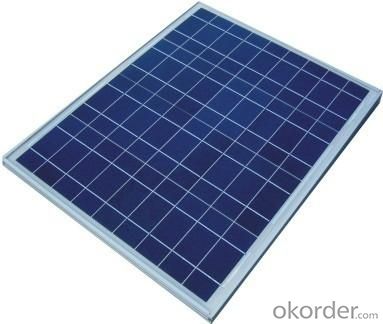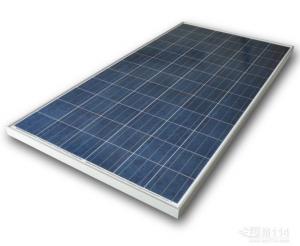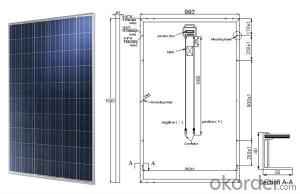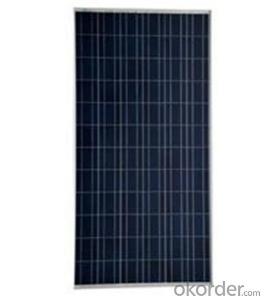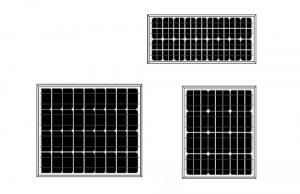500 W High Efficiency Polycrystalline Solar Panels Made in China
- Loading Port:
- Shanghai
- Payment Terms:
- TT OR LC
- Min Order Qty:
- 1000 pc
- Supply Capability:
- 100000 pc/month
OKorder Service Pledge
OKorder Financial Service
You Might Also Like
Product Description:
Details Of Polycrystalline Solar Panel
I Solar Cell : High efficiency crystalline solar cell. Even if under the weak light, the solar module can produce maximum power output.
II Tempered glass (toughened glass): Anti-reflecting coating and high transmission rate glass increase the power output and mechanical strength of solar module.
III EVA and TPT: Using high quality EVA and TPT to prevent destroying and water.
IV AI frame: Without screw, corner connection. 6 holes on the frame can be installed easily.
V Junction box: Multi function junction box with water proof.
VI Long lifetime: ≥25 years; Less power decrease.
VII Good performance of preventing from atrocious weather such as wind and hails.
VIII Resisting moisture and etching effectively, not effected by geology. .
Temperature Coefficient of Polycrystalline Solar Panel
NOCT | 47℃±2℃ |
Temperature Coefficients of Isc (%/℃) | 0.064 |
Temperature Coefficients of Voc (%/℃) | -0.33 |
Temperature Coefficients of Pmp (%/℃) | -0.45 |
Operating Temperature | –40 °C to +85°C |
Storage Temperature | –40 °C to +85°C |
Max System Voltage | 700V |
Products Guarantee | 2 yrs free from defects in materials and workmanship |
Performance Guarantee | No less than 90% within 10yrs and no less than 80% within 20yrs |
Certificates | ISO, TUV, CE |
Standard Test Conditions of Polycrystalline Solar Panel
The opto-electrical specifications shown below are stabilized values being measured at Standard Test Conditions of multicrystalline silicon Solar Panel, Irradiance: 1000W/m2, Spectrum: AM1.5 at 25°C, The info below is subject to manufacturing tolerances. Where appropriate minutes of measurement are available and are used for the dimensioning of the installation.
Advantages of Polycrystalline Solar Panel
• CNBM Solar performance guarantees for 25 years
• 12 years guarantee for workmanship for multicrystalline silicon Solar Panel
Product Description of Polycrystalline Solar Panel
CNBM Solar Polycrystalline Series (25W—310W)
CNBM Solar photovoltaic (PV)module is designed for large electrical power requirements. It is the optimal choice for both on-grid and off-grid power systems. CNBM Solar panel offers high performance of power per square foot of solar array.Poly- or multicrystalline silicon(poly-Si or mc-Si): made from cast square ingots — large blocks of molten silicon carefully cooled and solidified. Poly-Si cells are less expensive to produce than single crystal silicon cells, but are less efficient. US DOE data shows that there were a higher number of multicrystalline sales than monocrystalline silicon sales.
- Q: Can solar panels be used to power a factory?
- Yes, solar panels can be used to power a factory. Solar panels generate electricity by converting sunlight into energy, which can be used to power various operations in a factory. However, the feasibility and effectiveness of using solar panels to power a factory would depend on factors such as the size of the factory, energy requirements, available sunlight, and the capacity of the solar panel system.
- Q: How do solar panels affect the property's energy consumption?
- Solar panels can significantly reduce a property's energy consumption by generating clean and renewable electricity directly from the sun. These panels convert sunlight into usable energy, which can power various appliances and systems within the property, thereby reducing the reliance on traditional energy sources and lowering electricity bills.
- Q: What is the average lifespan of a solar panel?
- The average lifespan of a solar panel is typically around 25 to 30 years.
- Q: Photosynthesis is fairly inefficient, but efficient enough to power all life on earth.
- One of the primary reasons solar cells are made of silicon is that the bandgap energy of silicon happens to be nearly equal to the energy of visible light, which is the major portion of energy emitted by the sun. Therefore, silicon is the ideal substance to fabricate solar cells with.
- Q: How much energy can solar panels generate?
- The amount of energy that solar panels can generate depends on various factors such as the size and efficiency of the panels, the amount of sunlight received, and the geographical location. On average, a residential solar panel system can generate between 10 to 20 kilowatt-hours (kWh) of electricity per day. However, larger commercial or utility-scale solar installations can generate significantly more energy, sometimes even in the megawatt range.
- Q: I'm doing a project for school and I'm a little confused about energy and solar panels. I'm looking to propose installation of solar panels to power the computer lab at my school. From what I've read a computer and monitor use roughly 350 watts per hour. I was looking at solar panels and it says they produce various wattage. For example, I was looking at one rated at 200 watts. Does that mean 200 watts in a day? Or per hour? Please help.
- The rating of a solar panel is a maximum continuous rating. A 200 Watt panel will give a maximum of 200 watts under ideal conditions. A computer and monitor use about 400 Watts. not per hour - watts is Volts * Amps and a measure of Power. In hour a computer and monitor uses 400 Watt hours (Wh). Wh is a measure of Energy. To power a lab of 0 computers you will need 0* 400 = 4000 Watts. To run this from solar panels through the day only you would need a 4000 Watt panel. Except - its cloudy, the sun is in the wrong place - many factors reduce the output. To be reasonably safe you would need about a 2000 Watt panel. Then you would need batteries to store power through dull periods AND a voltage converter to change from low voltage DC from the solar panels to the mains voltage for your computers.
- Q: Can solar panels be installed on a recreational vehicle (RV)?
- Yes, solar panels can be installed on a recreational vehicle (RV). Many RV owners choose to install solar panels on their vehicles to generate electricity and reduce their reliance on traditional power sources while on the road. Solar panels can provide a sustainable and eco-friendly solution for powering various appliances and systems in an RV, making it more self-sufficient and energy-efficient.
- Q: How do solar panels impact the roofing material's lifespan?
- Solar panels can actually extend the lifespan of roofing materials. They act as a protective layer, shielding the roof from various weather elements like UV rays, hail, and rain, which can cause damage over time. Additionally, solar panels can help regulate the temperature of the roof, preventing excessive heat buildup that can accelerate the degradation of roofing materials.
- Q: The battery is 9ah and the solar panel is 20w
- Buy the proper charger or get a degree. Don't screw with making a charger for a lead acid battery of you don't know what you are doing. You could get hurt. You need a hell of a lot more than just a regulator.
- Q: Can solar panels be installed on a pergola or awning?
- Yes, solar panels can be installed on a pergola or awning. In fact, they can be a great option for maximizing solar energy production while providing shade and protection from the elements.
Send your message to us
500 W High Efficiency Polycrystalline Solar Panels Made in China
- Loading Port:
- Shanghai
- Payment Terms:
- TT OR LC
- Min Order Qty:
- 1000 pc
- Supply Capability:
- 100000 pc/month
OKorder Service Pledge
OKorder Financial Service
Similar products
Hot products
Hot Searches
Related keywords



